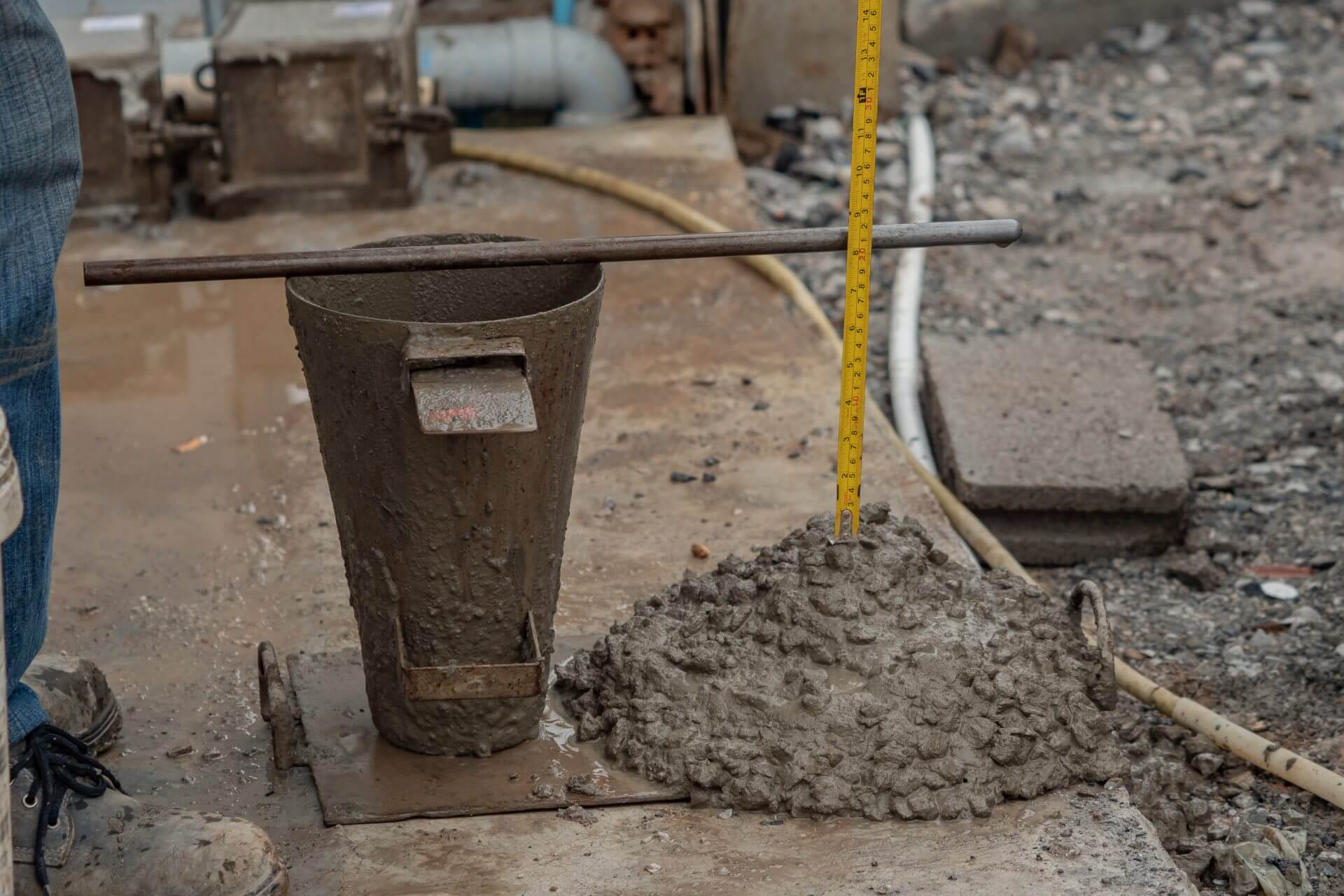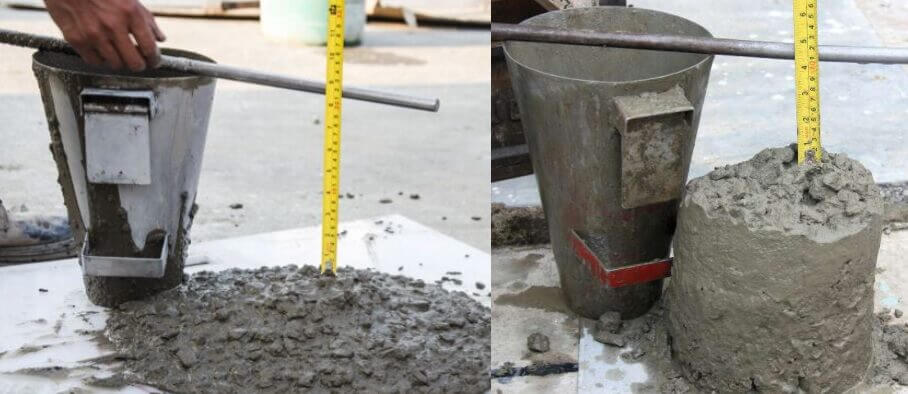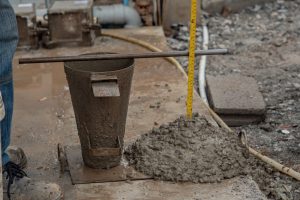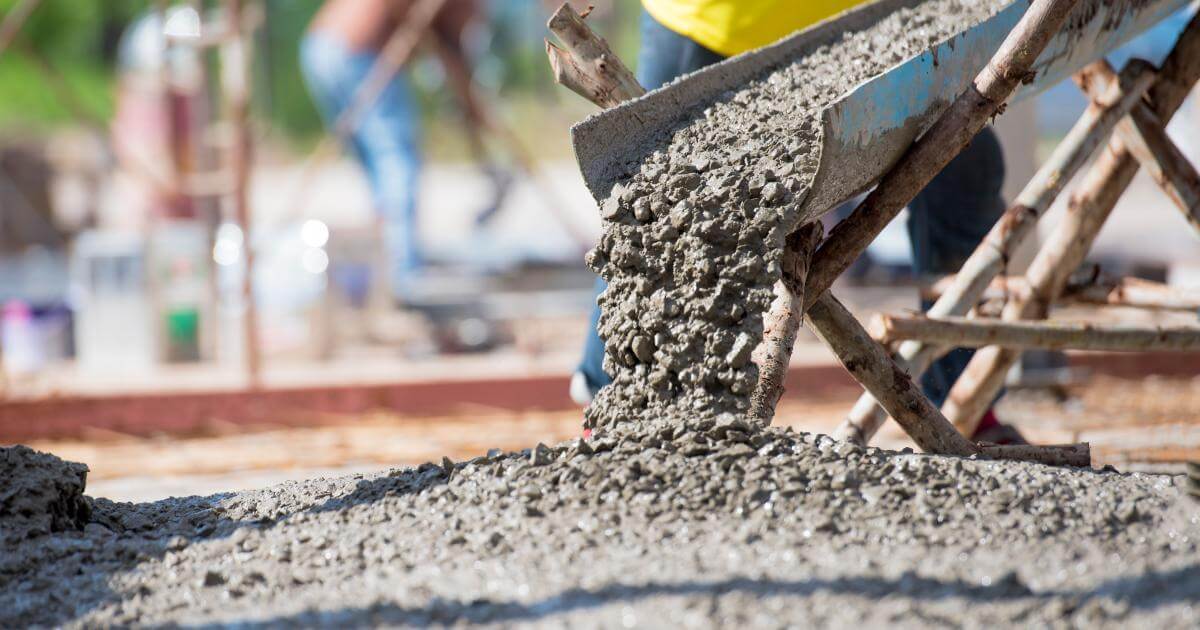
The Concrete Slump Test, according to the 6th edition of the Portland Cement Association’s Design and Control of Concrete Mixtures (1940), is a crude measure of consistency, which is a broad term for fluidity or wetness. “This test was not an absolute measure of workability and should not be used to compare blends of completely different proportions or aggregate types,” it stated. Changes in consistency, as shown by the Concrete Slump, are important in showing changes in the character of the material, the proportions, or the water content under conditions of consistent operations.” Surprisingly, the prescribed concrete slumps were fairly generous, as shown below.
- 1 to 4 in. thick sections, pavements, and floors laid on the ground
- 3 to 6 in. thick slabs, beams, or walls
- 4 to 8 in. thick walls and columns, standard slabs or beams
This was back when the only ingredients in concrete for building construction were cement, water, and fine and coarse aggregate. So, using water, an 8-in. slump was created, yielding concrete strengths ranging from 2500 psi—w/c = 7-3/4 gal/sack (0.68 by weight)—to 3750 psi—w/c = 6 gal/sack (0.68 by weight) (0.53 by weight).

The 6th edition additionally includes a recommended specification for plain and reinforced concrete, with quality determined by the water-cement ratio and workability. Concrete Slump restrictions, on the other hand, were not set. “The proportions of aggregates to cement for any concrete shall be such that the mixture will work readily into corners and angles of the forms and around reinforcement with the method of placing employed on the work without allowing the material to segregate or excess free water to collect on the surface,” according to the specification.
ACI Committee 301 (401) had created a proposed Specification for Structural Concrete for Buildings by 1960, which was submitted as a progress report at the ACI annual convention in March 1960. The maximum droop and slump allowed in this document and subsequent editions had been drastically reduced.
The reduction in maximum permissible slump was most likely based on the belief that higher slumps meant increased water content, which meant poor quality concrete with poorer strengths and water tightness. That, on the other hand, would have assumed that the cement content remained constant and that all other factors affecting slump remained constant—a reasonable assumption in the 1960s. It’s a bad assumption nowadays.
Daczco presented the findings of numerous tests on concrete mixtures prepared with virtually the same water and cement quantity, no admixtures, and sands from two different sources. Table 2 shows the slumps for the following two mixes. The water and paste content of the higher concrete slump are the same as the lower slump concrete. Other elements are at play as well.
They mark the non-conformance in their daily report because the slump is 12 in. over the maximum value. This can lead to a disagreement over the last truckload’s possible bad performance. With a strict follow-the-rules inspector, this isn’t an issue. There’s an issue with the standard.
Concrete specifications contained criteria for either a maximum slump or a slump range for many years after the first ASTM procedure for slump was published in 1922. Higher slumps were thought to imply lower concrete strengths, so the test might be used to prevent high-slump, supposedly low-strength concrete from being utilized in pavements or structural elements. The logic for utilizing slump as a strength indication, however, is no longer valid.
The Predicament
Other factors such as aggregate grading, fines content (cement and extra cementitious materials), entrained air content, and especially water-reducing admixtures can all have a significant impact on slump and slump loss, even if the water quantity remains constant. As a result, slump is no longer a reliable predictor of the quality of hardened concrete.
In Note 1 of Section 4.1 of the ASTM Test Method for Slump of Hydraulic-Cement Concrete (ASTM C143), the following is now stated:
“The purpose of this test method was to provide a way for monitoring the consistency of unhardened concrete. The concrete slump is often observed to grow proportionally with the water content of a particular concrete mixture under laboratory circumstances, with strict control of all concrete materials, and thus to be inversely related to concrete strength. However, such a link is not clearly and consistently demonstrated in the field. As a result, when connecting slump results acquired under field conditions to strength, caution should be exercised.”

Slump has an effect on how easily concrete can be moved, laid, and screened, and it’s a good indicator of batch-to-batch variation. It is therefore critical for contractors who must pour and finish the concrete. When exceptionally flat floors are requested, for example, concrete floor construction necessitates rigorous slump control. A high-Concrete Slump truckload in one section of the floor might delay finishing and make it harder to achieve the desired flatness, whereas a low-slump truckload can cause placement issues and delays on pumped concrete jobs.
Slump impacts the ease with which concrete may be poured and solidified to minimize honeycomb and bug-holes, which is vital for constructing structural parts like columns and walls. As a result, it’s in the contractors’ best interests to keep fresh concrete’s slump and other qualities under control. To accomplish slumps within an agreed-upon range, they must collaborate closely with their concrete producer. However, that range should not be included in the requirements because they are required to manage the hardened concrete’s performance; tests for compressive strength and air content are now the most effective means of controlling both concrete strength and durability.
The National Ready Mixed Concrete Association has been lobbying for the use of performance rather than prescriptive requirements for more than ten years. Some restrictions in prescriptive specifications, they believe, are unnecessary. One of these is Concrete Slump. believe, as do we, that the slump range should be determined by a cooperation between the concrete contractor and the concrete producer.
Read about concrete stamps here.
A Checklist for Concrete Producer-Concrete Contractor Fresh Concrete Performance Expectations was published by ASCC and NRMCA in 2012. Before the finite element analysis, this checklist is used to identify the duties of the concrete producer and contractor for predicted concrete qualities and placement procedures.
Then, in circumstances when the slump surpasses a predetermined limit, contractors, rather than inspectors, can consider the benefits and drawbacks before deciding on a course of action. Making and testing a set of cylinders could be an alternative if there is any concern regarding the quality of the hardened concrete. However, rejecting a load of concrete solely on the basis of slump is currently supported only by old notions. Slump criteria should be removed from specifications for this reason.
One of the most important characteristics of any concrete is its workability, or how easy it is to push one way, pull the other, and float to a smooth level surface. The fluidity of the concrete has a big impact on its workability. “Slump” is the term for this. Basically, the higher the slump, the more fluid the concrete is. Although slump is commonly regarded as a metric of water content, it can also be read as a measure of consistency.
Consistency (workability or Concrete Slum) is now described as being of a certain class, thanks to the introduction of the new European Standard for Concrete in 2003 (BS8500).
There are five different classes, each having a different range of slump values.
| Class | Slump range (mm) | Target slump |
| S1 | 10-40 | 20 |
| S2 | 50-90 | 70 |
| S3 | 100-150 | 130 |
| Table 1: Slump class from BS8500 | ||
The following is a rough guide to usage.
- Because S1 slumps are a rather dry concrete mix, they are most commonly utilized for kern and piping beds. This is referred described as “semi-dry” in some cases.
- S2 slumps are used for simple strip footings and cast in-situ hard-standing slabs, as well as when moving concrete with a wheel barrow. This is known as a “wet mix,” and it is arguably the most useful and widely stated consistency.
- S3 would be utilized for trench-fill foundations that demand a lot of flow. This is referred to as a “wet mix.”
What does a slump test entail?
A relatively easy test utilizing incredibly inexpensive equipment determines the droop of a concrete (or mortar). Although all ready mix concrete providers will test the slump of their delivered product upon request, the testing gear is readily available from contractor’s tool suppliers.







